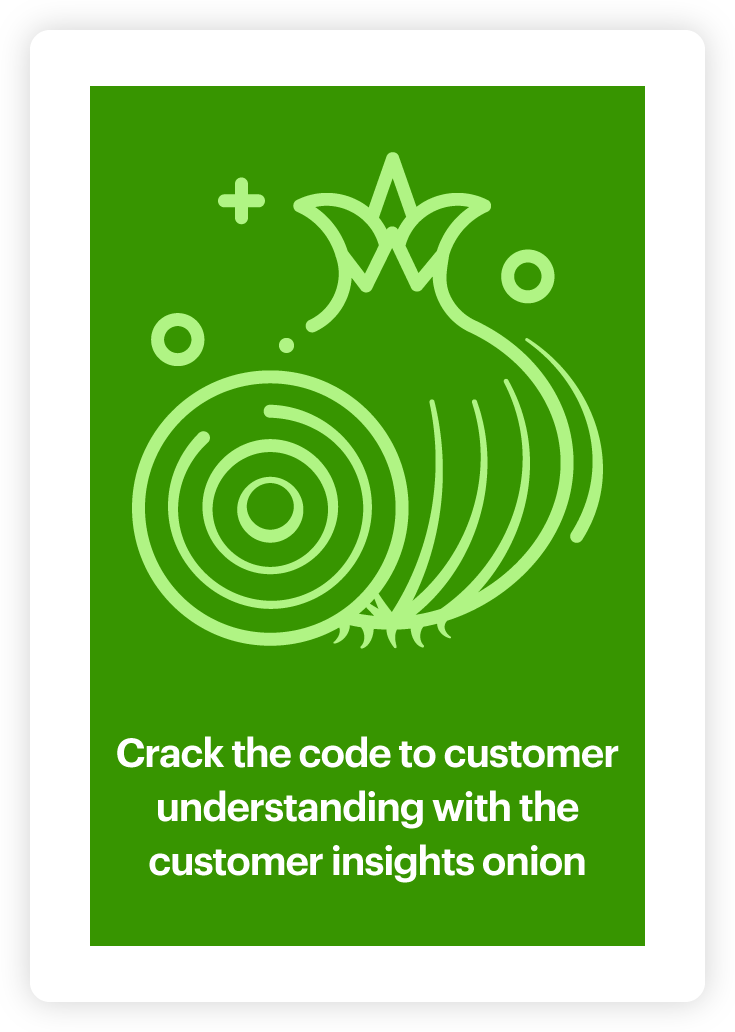An introductory guide to customer insights tools

Customer insights tools are quickly becoming a must-have for customer experience teams looking to efficiently gain insights from mountains of customer feedback.
But before we dive deeper into the key features of customer insights tools, let’s start by answering the question: What is customer insight and why is it important? Customer insight is generally defined as the process of uncovering actionable intelligence in your customer data. This type of intelligence can help you pinpoint customers’ needs, wants, likes, and dislikes so that you can better understand the drivers of customer experience and satisfaction.
Customer insights are generated by analyzing a combination of customer feedback and behavioral customer data. Common sources of customer data include survey responses, social media and forum conversations, customer service transcripts, and online reviews. Brands typically take one of two approaches to analyzing these types of qualitative text data: manual human-led analysis or automated analysis using a consumer insights tool.
What are customer analytics tools?
Customer insights tools use a combination of AI and natural language processing (NLP) to understand text and detect linguistic patterns within customer feedback data. They can do simple things like spotting frequent usage of words and phrases and more complex things like surfacing emotions or sentiments prevalent in customer reviews. Customer insight tools work by breaking down text into smaller components following a set of rules coded into the software. They then report on the contents and context of the data being analyzed, allowing users to understand the important features of their feedback data without having to read every word individually.
What are the benefits of using customer insights tools?
The most obvious advantage of investing in a consumer insights platform is time-saving. Whereas manual, human-led analysis is cumbersome and time-consuming, a customer insights tool can analyze masses of text data in minutes. What’s more, automated, AI-powered text analysis mitigates the potential for human error and bias in your analysis. When doing analysis manually, humans are prone to focus on the things that confirm existing ideas or hypotheses. The same is not the case when automating the process with technology.
Other key benefits include:
- Extract qualitative consumer insights from masses of customer feedback data in minutes
- Bring a big data approach to unstructured qualitative data
- Save money by reducing the need for manual analysis and expensive agencies
- Remove bias from the analysis process
- Leverage data sources you would have previously ignored
- Spend more time on data storytelling and strategizing rather than sifting through data
What are the key features of consumer insights tools?
Every customer feedback analysis tool employs a different methodology and comes with a different feature set. There are six key features you should be aware of when researching customer insights tools:
- Word frequency analysis
- Topical classification
- Emotion or sentiment analysis
- Visualization tools
- Data upload and segmentation
- Data set comparisons
Let’s look at each of these features in more detail.
Word frequency analysis
Customer feedback tends to take the form of unstructured text data – in other words, it’s made up of words! Because of this, the best consumer insights tools are the ones that are powered by a robust text analytics engine that is equipped to analyze these words in a sophisticated way. Traditional customer insights tools tend to be based on word frequency analysis. Word frequency analysis is the basic form of text analysis. It identifies the most commonly used words and/or phrases in a given data set. The most dominant words and phrases are then visualized in a frequency table or a word cloud. In the case of word clouds, the size of the word equals the frequency of its occurrence within the analyzed text data.
The problem with word clouds and simple frequency analysis is that they tend to surface topic-specific vocabulary that is obvious or expected, failing to capture the context and nuance around what your customers are saying.
Let’s consider an example:
You’re a retailer and want to analyze how customers are talking about you on social media. A word cloud or frequency table will more than likely highlight words such as ‘shopping’, ‘check out’ and ‘store’. The problem is that none of these words are particularly insightful because they represent the general vocabulary of going shopping. In other words, frequency analysis tends to surface the words you would expect to find – and we all know that the best insights are the ones that surprise you!
Thankfully, good customer insights tools take analyzing customer feedback a few steps further with additional features.
Topical classification
Topical text classification uncovers key themes within customer feedback data. Most consumer insights tools offer some combination of out-of-the-box topical classification, as well as the ability to define and analyze custom, user-defined topics. Oftentimes, however, the accuracy of topical classifications is hindered by the fact that words can take on context-specific meanings. Whereas more basic text classification tools can struggle to distinguish between such context-specific meanings, customer insights platforms equipped with AI-powered topical text classification capabilities can make more nuanced and reliable judgments on how a word is being used.
Here’s an example:
You work for a software company and are conducting a survey to find out how people feel about your newest software update. Survey responses show that a large portion of your respondents love that the update is mitigating ‘pain’ points they’ve been struggling with, while many others find that it is causing them ‘pain’. An unsophisticated customer insights tool won’t be able to differentiate between these uses whereas an AI-powered tool like Relative Inisght will be better equipped for the task.
Emotion or sentiment analysis
Sentiment analysis tools aim to classify text as positive, negative, or neutral. While this might be useful on a basic level, it doesn’t provide you with real insight concerning your customers’ emotions.
A customer insights platform like Relative Insight will help you acquire a deep emotional understanding of your audiences, using emotional text analysis to distinguish between feelings like joy, hope, frustration, or contentment.
Here’s an example to illustrate the difference between emotional and sentiment text analysis:
Reviewing their customer service experience, one of your customers says: “I wish I could say I was happy about my customer service interactions, but the customer service representative was far from friendly and our interaction was anything but helpful.”
A standard sentiment analysis tool might label this review as positive, picking out the words ‘happy’, ‘helpful’, and ‘friendly’. An emotional text analysis tool like Relative Insight would be better equipped and spot the underlying dissatisfaction by distinguishing between ‘friendly’ and ‘far from friendly’ or ‘helpful’ and ‘anything but helpful’.
Visualization tools
In addition to helping you pinpoint how people are talking about topics relevant to your business, customer insights tools also offer data visualizations. Such visualizations will allow you to spot otherwise unnoticed trends in your data and enable you to take proactive or corrective actions.
Relative Insight Heartbeat is one such visualization tool. Heartbeat allows you to track changes in the prevalence of key topics in customer feedback and social media conversations over time. A marketing specialist, for example, might use such a visualization tool to track changes in customer conversations before and after a specific marketing campaign. In line with this, they could define themes they want to track, e.g. good product quality vs. bad product quality or good customer service vs. bad customer service.
Another way to visualize data with Relative Insight is with Heatmaps. Heatmaps allow you to quickly identify which data sets have the most and least in common. Visualizations like this allow you to communicate your findings in a simple and understandable way and include reporting on qualitative customer insights analytics alongside existing quant reporting.
Data upload and segmentation
Customer insights tools generally offer a variety of ways to upload customer data for analysis. Options include a simple .csv or Excel file upload or joining up data sources directly by using anAPI connection or integration.
Once you’ve uploaded your text data, customer insights platforms provide you with a host of tools that help you filter, clean, and segment your data. A common way businesses choose to segment customer data is based on Net Promoter Score (NPS), Customer Satisfaction Score (CSAT) and/or Customer Effort Score (CES). Taking this approach, customer insights teams can compare high and low scoring response to reveal drivers of customer (dis)satisfaction.
By taking advantage of these automated tools, you can save time and effort and can instead spend more time focused on what these insights mean for your business.
Data set comparisons
Customer insights analysis tools like Relative Insight offer users the ability to compare relevant data sets to efficiently identify differences and similarities between them. This helps to boost contextual understanding. Comparison can help you dive deeper into your data by showcasing the differences between different customer segments or changes over time. Popular examples of such comparisons include comparing 1- and 5-star reviews, survey responses from high and low-value customers or from different geographic markets.
Choosing the right customer insights platform
Although each of the above-mentioned features of customer insights tools can be helpful standing alone, a great consumer insights platform will allow you to combine and use all of these features, surfacing valuable quantitative customer insights as well as qualitative customer insights from your text data at scale.
But this is not the only thing you should keep in mind when considering adding a new customer insights tool to your business intelligence toolkit. Most importantly, you should have a clear set of objectives and find out how your existing processes and work structures would need to be adapted.
First, you should think about which customer feedback data sources you are going to analyze. This involves identifying the data sources you already have available and how you might enrich your data pool to get more value from a consumer insights tool. You should also understand what you are hoping to learn from each of your data sources and how this will impact your decision-making and support your business objectives.
Lastly, you should ask yourself who in your business will be using the customer insights platform. Keep in mind that customer insights platforms are an addition and not a replacement for the wonderful humans on your insights team. Getting the most out of a customer insights tool requires skilled users who have the knowledge and expertise to use your new platform to its full potential.
Relative Insight combines all the best features of text analysis tools into one powerful customer insights platform. What’s more, we provide training for your users and offer you dedicated support to help you get the most out of your customer data. Download our introductory guide to customer insights or book a no-commitment discovery call to learn more about how our customer insights tool can help you make customer-centric decisions!
